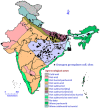Rediscovering the Potential of Multifaceted Orphan Legume Grasspea- a Sustainable Resource With High Nutritional Values
- PMID: 35281763
- PMCID: PMC8906286
- DOI: 10.3389/fnut.2021.826208
Rediscovering the Potential of Multifaceted Orphan Legume Grasspea- a Sustainable Resource With High Nutritional Values
Abstract
The genus Lathyrus consists of more than 184 herbaceous annual and perennial species suitable for multifaceted sustainable food and feed production system in the arid and semi-arid regions of the world. The grasspea is a promising source of protein nutrition. However, its potential is not being utilized fully due to the presence of neurotoxin content (β-N-oxalyl-l-α, β diaminopropionic acid, β-ODAP), a causal agent of non-reversible lower limbs paralysis. The high protein contents in seeds and leaves with ~90% digestibility make it sustainable super food to beat protein malnutrition in future. Therefore, it is desired to breed new grasspea cultivars with low β-ODAP contents. Limited research has been carried out to date about this feature. A draft genome sequence of grasspea has been recently published that is expected to play a vital role in breeding and identifying the genes responsible for biosynthesis pathway of β-ODAP contents in grasspea. Efforts to increase awareness about the importance of genus Lathyrus and detoxify β-ODAP in grasspea are desired and are in progress. Presently, in South Asia, systematic and dedicated efforts to support the farmers in the grasspea growing regions by disseminating low β-ODAP varieties has resulted in a considerable improvement in reducing the incidence of neurolathyrism. It is expected that the situation will improve further by mainstreaming grasspea cultivation by implementing different approaches such as the development and use of low β-ODAP varieties, strengthening government policies and improved detox methods. The present review provides insight into the multifaceted characteristics of sustainable nutritious grasspea in the global and Indian perspective.
Keywords: climate-resilient; grasspea; multifaceted; orphan legume; sustainable.
Copyright © 2022 Ramya, Tripathi, Pandey, Barpete, Gore, Raina, Khawar, Swain and Sarker.
Conflict of interest statement
The authors declare that the research was conducted in the absence of any commercial or financial relationships that could be construed as a potential conflict of interest.
Figures






References
-
- Arora NK. Impact of climate change on agriculture production and its sustainable solutions. Environ Sustain. (2019) 2:95–6. 10.1007/s42398-019-00078-w - DOI
-
- Grebmer K, Bernstein J, Alders R, Dar O, Kock R, Rampa F, et al. . Global Hunger Index: One Decade to Zero Hunger: Linking Health and Sustainable Food Systems. Bonn: Welthungerhilfe; (2020).
-
- Food Agricultural Organization of the United Nations (FAO); International Fund for Agricultural Development (IFAD); United Nations Children's Fund (UNICEF); World Food Programme (WFP); World Health Organization (WHO). The State of Food Security and Nutrition in the World 2020 and Transforming Food Systems for Affordable Healthy Diets For All. Rome: Food and Agriculture Organization of the United Nations; (2020). Available online at: https://www.fao.org/3/ca9692en/online/ca9692en.html
-
- World Health Organization (2018) . Available online at: https://www.who.int/news-room/fact-sheets/detail/malnutrition (accessed December 19, 2021).
-
- Global Nutrition Report. Available online at: https://globalnutritionreport.org/reports/global-nutrition-report-2018/b... (accessed December 16, 2020).
Publication types
LinkOut - more resources
Full Text Sources

